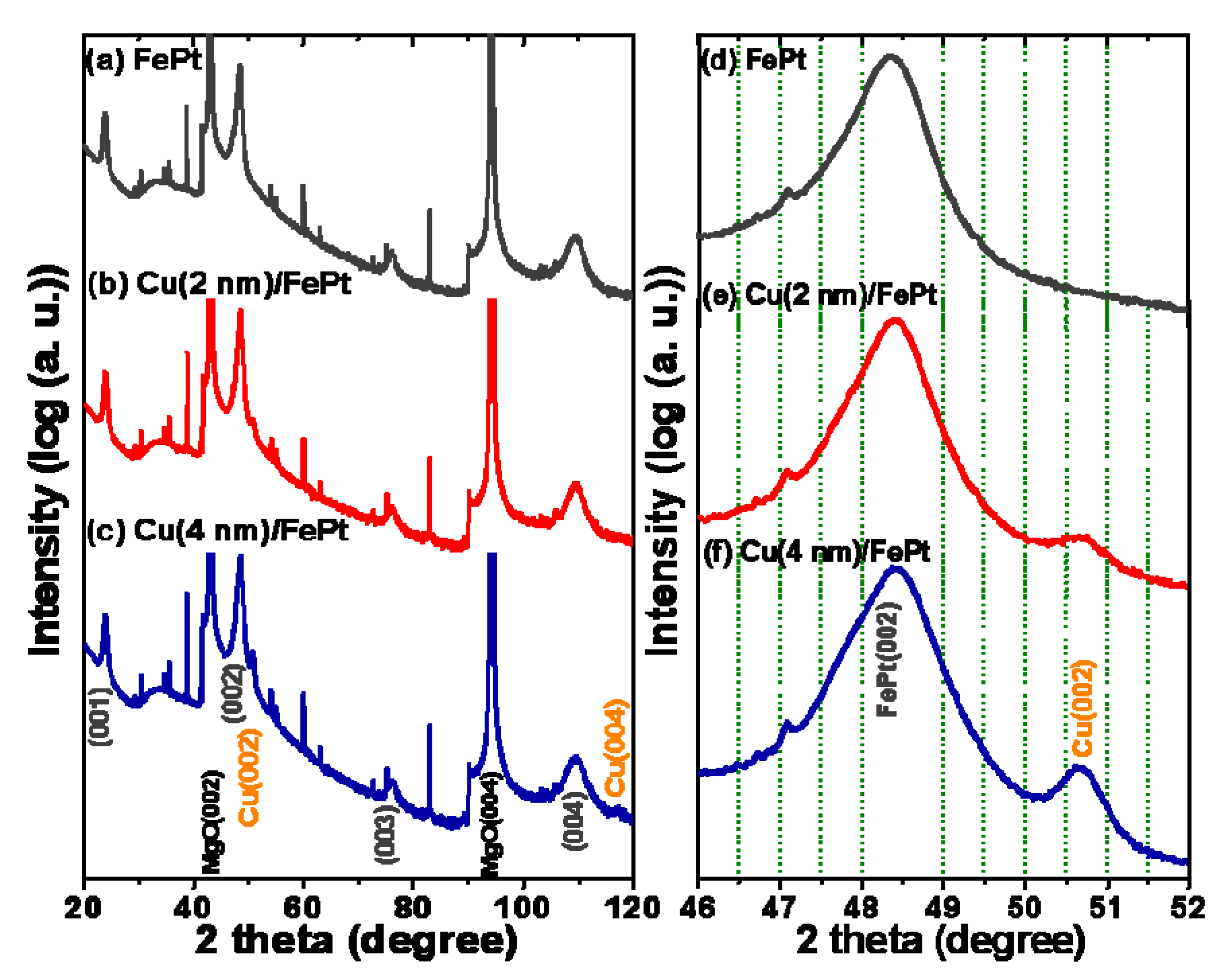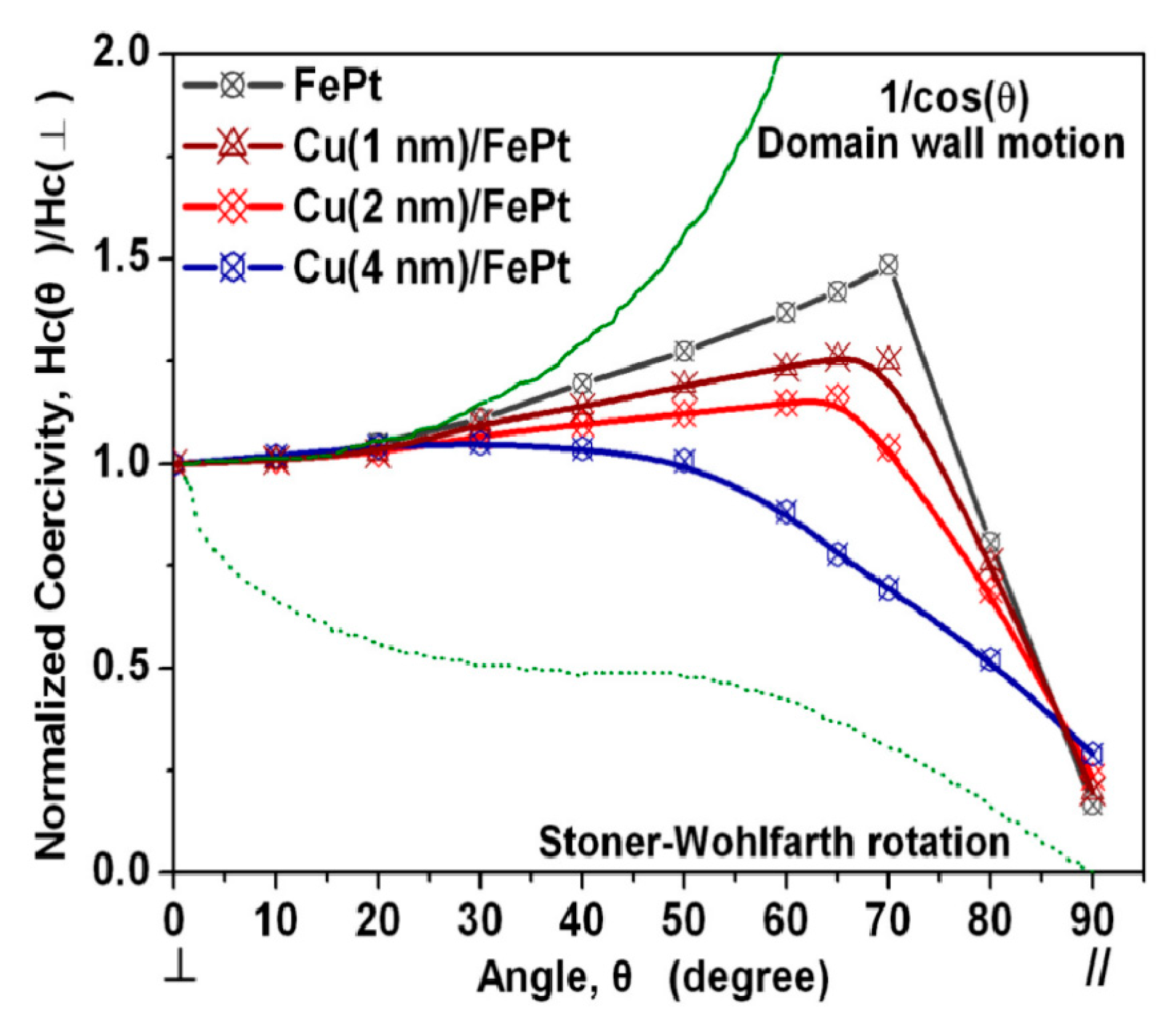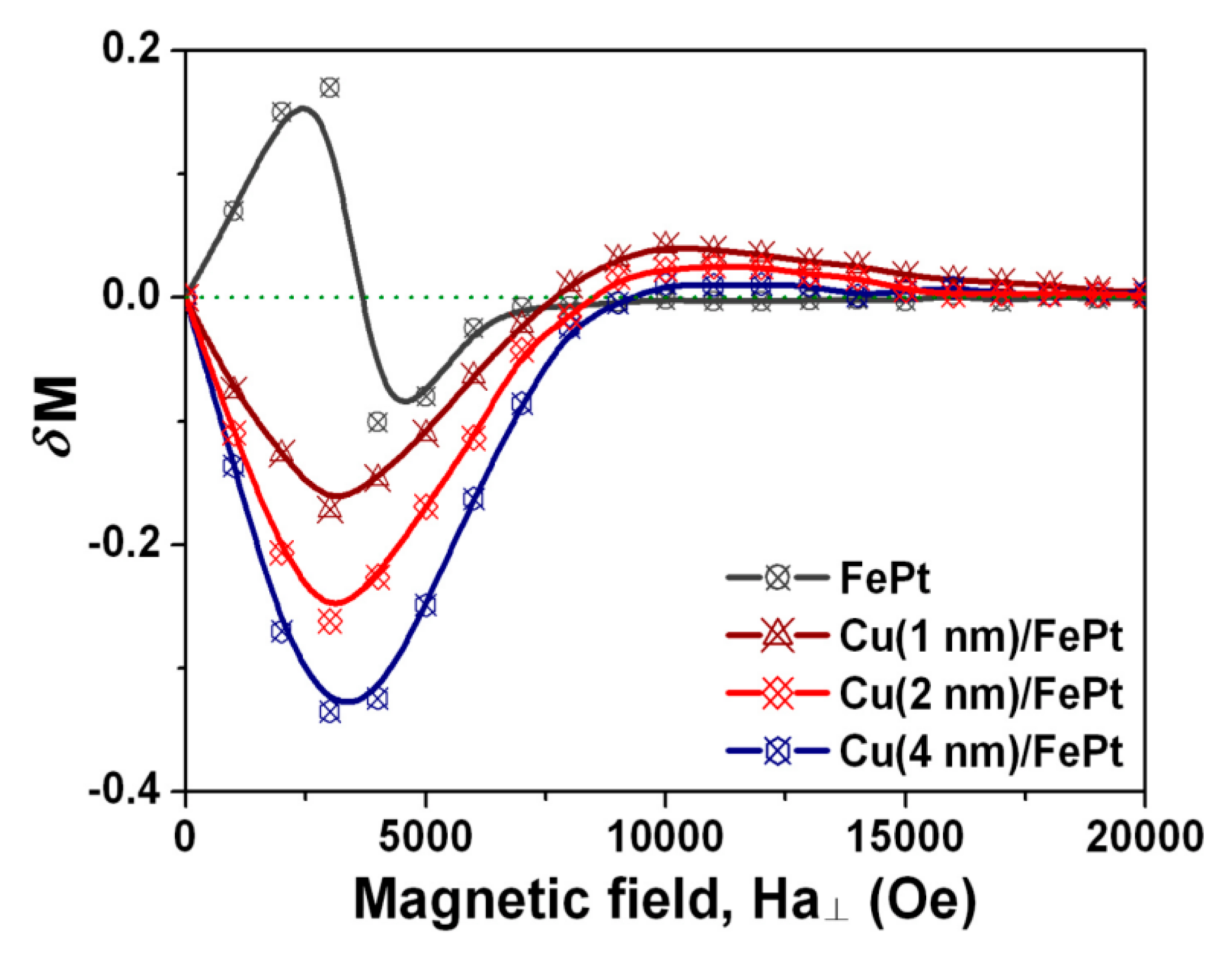Controlled Magnetic Isolation and Decoupling of Perpendicular FePt Films by Capping Ultrathin Cu(002) Nano-Islands
Abstract
1. Introduction
2. Experiments and Composite Film Structures
3. Results and Discussion
4. Conclusions
Author Contributions
Funding
Acknowledgments
Conflicts of Interest
References
- Weller, D.; Moser, A.; Folk, L.; Best, M.E.; Lee, W.; Toney, M.F.; Schwickert, M.F.; Thiele, J.U.; Doerner, M.F. High Ku materials approach to 100 Gbits/in2. IEEE Trans. Magn. 2000, 36, 10–15. [Google Scholar] [CrossRef]
- Ravindran, P.; Kjekshus, A.; Fjellvåg, H.; James, P.; Nordström, L.; Johansson, B.; Eriksson, O. Large magnetocrystalline anisotropy in bilayer transition metal phases from first-principles full-potential calculations. Phys. Rev. 2001, 63, 144409. [Google Scholar] [CrossRef]
- Albrecht, M.; Rettner, C.T.; Moser, A.; Best, M.E.; Terris, B.D. Recording performance of high-density patterned perpendicular magnetic media. Appl. Phys. Lett. 2002, 81, 2875. [Google Scholar] [CrossRef]
- Yan, M.L.; Powers, N.; Sellmyer, D.J. Highly oriented nonepitaxially grown L10 FePt films. J. Appl. Phys. 2003, 93, 8292. [Google Scholar] [CrossRef]
- Shima, T.; Takanashi, K.; Takahashi, Y.K.; Hono, K. Coercivity exceeding 100 kOe in epitaxially grown FePt sputtered films. Appl. Phys. Lett. 2004, 85, 2571. [Google Scholar] [CrossRef]
- Wang, J.P. Tilting for the top. Nat. Mater. 2005, 4, 191. [Google Scholar] [CrossRef]
- Thomson, T.; Hu, G.; Terris, B.D. Intrinsic distribution of magnetic anisotropy in thin films probed by patterned nanostructures. Phys. Rev. Lett. 2006, 96, 257204. [Google Scholar] [CrossRef]
- Chappert, C.; Fert, A.; van Dau, F.N. The emergence of spin electronics in data storage. Nat. Mater. 2007, 6, 813–823. [Google Scholar] [CrossRef]
- Seki, T.; Hasegawa, Y.; Mitani, S.; Takahashi, S.; Imamura, H.; Maekawa, S.; Nitta, J.; Takanashi, K. Giant spin Hall effect in perpendicularly spin-polarized FePt/Au devices. Nat. Mater. 2008, 7, 125–129. [Google Scholar] [CrossRef]
- Wei, D.H.; Yao, Y.D. Controlling microstructure and magnetization process of FePd (001) films by staged thermal modification. Appl. Phys. Lett. 2009, 95, 172503–1–172503–3. [Google Scholar] [CrossRef]
- Vogler, C.; Abert, C.; Bruckner, F.; Suess, D.; Praetorius, D. Heat-assisted magnetic recording of bit-patterned media beyond 10 Tb/in2. Appl. Phys. Lett. 2016, 108, 102406. [Google Scholar] [CrossRef]
- Wu, C.; Jiang, Y.; Niu, Z.; Zhao, D.; Pei, W.; Wang, K.; Wang, Q. Effects of high magnetic field annealing on FePt nanoparticles with shape-anisotropy and element-distribution-anisotropy. RSC Adv. 2021, 11, 10463–10467. [Google Scholar] [CrossRef]
- Lee, H.S.; Bain, J.A.; Laughlin, D.E. Use of bias sputtering to enhance decoupling in oxide composite perpendicular recording media. Appl. Phys. Lett. 2007, 90, 252511. [Google Scholar] [CrossRef]
- Wu, Y.C.; Wang, L.W.; Lai, C.H. Low-temperature ordering of (001) granular FePt films by inserting ultrathin SiO2 layers. Appl. Phys. Lett. 2007, 91, 072502. [Google Scholar] [CrossRef]
- Chen, J.S.; Lim, B.C.; Hu, J.F.; Liu, B.; Chow, G.M.; Ju, G. Low temperature deposited L10 FePt–C (001) films with high coercivity and small grain size. Appl. Phys. Lett. 2007, 91, 132506. [Google Scholar] [CrossRef]
- Seki, T.; Yako, H.; Yamamoto, T.; Kubota, T.; Sakuraba, Y.; Takanashi, K. Spin torque-induced magnetization dynamics in giant magnetoresistance devices with Heusler alloy layers. J. Phys. D Appl. Phys. 2015, 48, 164010-1–164010-8. [Google Scholar] [CrossRef]
- Dong, K.F.; Deng, J.Y.; Peng, Y.G.; Ju, G.; Chow, G.M.; Chen, J.S. Columnar structured FePt films epitaxially grown on large lattice mismatched intermediate layer. Sci. Rep. 2016, 6, 34637. [Google Scholar] [CrossRef]
- Li, W.; Chen, L. Grain growth mechanism and magnetic properties in L10-FePt thin films. AIP Adv. 2017, 7, 085203. [Google Scholar] [CrossRef]
- Zhang, Y.; Kalitsov, A.; Ciston, J.; Mryasov, O.; Ozdol, B.; Zhu, J.; Jain, S.; Zhang, B.; Livshitz, B.; Chernyshov, A.; et al. Microstructure and magnetic properties of ultrathin FePt granular films. AIP Adv. 2018, 8, 125018. [Google Scholar] [CrossRef]
- Bello, F.; Sanvito, S.; Hess, O.; Donegan, J.F. Shaping and Storing Magnetic Data Using Pulsed Plasmonic Nanoheating and Spin-Transfer Torque. ACS Photonics 2019, 6, 1524–1532. [Google Scholar] [CrossRef]
- Atkinson, L.J.; Evans, R.F.L.; Chantrell, R.W. Micromagnetic modeling of the heat-assisted switching process in high anisotropy FePt granular thin films. J. Appl. Phys. 2020, 128, 073907. [Google Scholar] [CrossRef]
- Ito, K.; Hayashida, M.; Masuda, H.; Nishio, T.; Goto, S.; Kura, H.; Koganezawa, T.; Mizuguchi, M.; Shimada, Y.; Konno, T.J.; et al. Epitaxial L10-FeNi films with high degree of order and large uniaxial magnetic anisotropy fabricated by denitriding FeNiN films. Appl. Phys. Lett. 2020, 116, 242404. [Google Scholar] [CrossRef]
- Suzuki, I.; Kubo, S.; Sepehri-Amin, H.; Takahashi, Y.K. Dependence of the Growth Mode in Epitaxial FePt Films on Surface Free Energy. ACS Appl. Mater. Interfaces 2021, 13, 16620–16627. [Google Scholar] [CrossRef]
- Chen, J.S.; Lim, B.C.; Wang, J.P. Controlling the crystallographic orientation and the axis of magnetic anisotropy in L10 FePt films. Appl. Phys. Lett. 2002, 81, 1848. [Google Scholar] [CrossRef]
- Takahashi, Y.K.; Hono, K. Interfacial disorder in the L10 FePt particles capped with amorphous Al2O3. Appl. Phys. Lett. 2004, 84, 383. [Google Scholar] [CrossRef]
- Zhou, M.J.; Li, Q.; Yang, F.J.; Wang, H.B.; Wang, H.; Tang, D. Structure and magnetic properties of FePt∕B4C multilayer thin films: Role of the compositional elements intermixing. Appl. Phys. Lett. 2007, 91, 061920. [Google Scholar] [CrossRef]
- Wei, D.H.; Yao, Y.D. Magnetization reversal mechanism and microstructure refinement of the FePt (001) nanogranular films With SiO2 capping layer. IEEE Trans. Magn. 2009, 45, 4092–4095. [Google Scholar] [CrossRef]
- Samal, S.; Kolinova, M.; Blanco, I. The magneto-mechanical behavior of active components in iron-elastomer composite. J. Compos. Sci. 2018, 2, 54. [Google Scholar] [CrossRef]
- Li, H.; Li, X.; Kim, D.; Zhao, G.; Zhang, D.; Diao, Z.; Chen, T.; Wang, J.P. High spin polarization in epitaxial Fe4N thin films using Cr and Ag as buffer layers. Appl. Phys. Lett. 2018, 112, 162407. [Google Scholar] [CrossRef]
- Klein, T.; Wang, W.; Yu, L.; Wu, K.; Boylan, K.L.M.; Vogel, R.I.; Skubitz, A.P.N.; Wang, J.P. Development of a multiplexed giant magnetoresistive biosensor array prototype to quantify ovarian cancer biomarkers. Biosens. Bioelectron. 2019, 126, 301–307. [Google Scholar] [CrossRef]
- Yamamoto, K.; Kubota, Y.; Suzuki, M.; Hirata, Y.; Carva, K.; Berritta, M.; Takubo, K.; Uemura, Y.; Fukaya, R.; Tanaka, K.; et al. Ultrafast demagnetization of Pt magnetic moment in L10-FePt probed by magnetic circular dichroism at a hard x-ray free electron laser. New J. Phys. 2019, 21, 123010. [Google Scholar] [CrossRef]
- Zhou, W.; Seki, T.; Imamura, H.; Ieda, J.; Takanashi, K. Spinmotive force in the out-of-plane direction generated by spin wave excitations in an exchange-coupled bilayer element. Phys. Rev. B 2019, 100, 094424. [Google Scholar] [CrossRef]
- Seki, T.; Iihama, S.; Taniguchi, T.; Takanashi, K. Large spin anomalous Hall effect in L10-FePt: Symmetry and magnetization switching. Phys. Rev. B 2019, 100, 144427. [Google Scholar] [CrossRef]
- Thiruvengadam, V.; Singh, B.B.; Kojima, T.; Takanashi, K.; Mizuguchi, M.; Bedanta, S. Magnetization reversal, damping properties and magnetic anisotropy of L10-ordered FeNi thin films. Appl. Phys. Lett. 2019, 115, 202402. [Google Scholar] [CrossRef]
- Saito, M.; Ito, H.; Suzuki, Y.; Mizuguchi, M.; Koganezawa, T.; Miyamachi, T.; Komori, F.; Takanashi, K.; Kotsugi, M. Fabrication of L10-FeNi by pulsed-laser deposition. Appl. Phys. Lett. 2019, 114, 072404. [Google Scholar] [CrossRef]
- Liu, L.; Qin, Q.; Lin, W.; Li, C.; Xie, Q.; He, S.; Shu, X.; Zhou, C.; Lim, Z.; Yu, J.; et al. Current-induced magnetization switching in all-oxide heterostructures. Nat. Nanotech. 2019, 14, 939–944. [Google Scholar] [CrossRef]
- Zhang, D.L.; Zhu, J.; Qu, T.; Lattery, D.M.; Victora, R.H.; Wang, X.; Wang, J.P. High-frequency magnetoacoustic resonance through strain-spin coupling in perpendicular magnetic multilayers. Sci. Adv. 2020, 6, eabb4607. [Google Scholar] [CrossRef]
- Zhao, Z.; Smith, A.K.; Jamali, M.; Wang, J.P. External-field-free spin hall switching of perpendicular magnetic nanopillar with a dipole-coupled composite structure. Adv. Electron. Mater. 2020, 6, 1901368. [Google Scholar] [CrossRef]
- Shu, X.; Zhou, J.; Deng, J.; Lin, W.; Yu, J.; Liu, L.; Zhou, C.; Yang, P.; Chen, J.S. Spin-orbit torque in chemically disordered and L11-ordered CuPt. Phys. Rev. Mater. 2020, 3, 114410. [Google Scholar] [CrossRef]
- Chan, M.H.; Hsieh, M.R.; Liu, R.S.; Wei, D.H.; Hsiao, M. Magnetically guided theranostics: Optimizing magnetic resonance imaging with sandwich-like kaolinite-based iron/platinum nanoparticles for magnetic fluid hyperthermia and chemotherapy. Chem. Mater. 2020, 32, 697–708. [Google Scholar] [CrossRef]
- Wang, X.; Krylyuk, S.; Josell, D.; Zhang, D.; Lyu, D.; Wang, J.P.; Gopman, D.B. Buffer layer engineering of L10 FePd thin films with large perpendicular magnetic anisotropy. AIP Adv. 2021, 11, 025106. [Google Scholar] [CrossRef]
- Liu, L.; Zhou, C.; Shu, X.; Li, C.; Zhao, T.; Lin, W.; Deng, J.; Xie, Q.; Chen, S.; Zhou, J.; et al. Symmetry-dependent field-free switching of perpendicular magnetization. Nat. Nanotech. 2021, 16, 277–282. [Google Scholar] [CrossRef] [PubMed]
- Maeda, T.; Kai, T.; Kikitsu, A.; Nagase, T. Akiyama, Reduction of ordering temperature of an FePt-ordered alloy by addition of Cu. J. Appl. Phys. Lett. 2002, 80, 2147–2149. [Google Scholar] [CrossRef]
- Maeda, T.; Kikitsu, A.; Kai, T.; Nagase, T.; Aikawa, H.; Akiyama, J. Effect of added Cu on disorder-order transformation of L10-FePt. IEEE Trans. Magn. 2002, 38, 2796–2798. [Google Scholar] [CrossRef]
- Takahashi, Y.K.; Ohnuma, M.; Hono, K. Effect of Cu on the structure and magnetic properties of FePt sputtered film. J. Magn. Magn. Mater. 2002, 246, 259–265. [Google Scholar] [CrossRef]
- Ding, Y.F.; Chen, J.S.; Liu, E. Controlling the crystallographic orientation and easy axis of magnetic anisotropy in L10 FePt films with Cu additive. Surf. Coat. Technol. 2005, 198, 270–273. [Google Scholar] [CrossRef]
- Matsumoto, S.; Shima, T. Magnetic properties of FePt thin films with multilayered structure. J. Phys. Conf. Ser. 2011, 266, 012038. [Google Scholar] [CrossRef]
- Lei, W.; Yu, Y.; Yang, W. Cu induced low temperature ordering of fct-FePtCu nanoparticles prepared by solution phase synthesis. J. Mater. Chem. C 2019, 7, 11632–11638. [Google Scholar] [CrossRef]
- Chou, S.C.; Yu, C.C.; Liou, Y.; Yao, Y.D.; Wei, D.H.; Chin, T.S.; Tai, M.F. Annealing effect on the Fe/Pt multilayers grown on Al2O3 (0001) substrates. J. Appl. Phys. 2004, 95, 7276. [Google Scholar] [CrossRef]
- Wei, D.H. Magnetic assembles of FePt (001) nanoparticles with SiO2 addition. J. Appl. Phys. 2009, 105, 07A715. [Google Scholar] [CrossRef]
- Wei, D.H. Perpendicular magnetization behavior of low-temperature ordered FePt films with insertion of Ag nanolayers. Materials 2016, 9, 209. [Google Scholar] [CrossRef]
- Himpsel, F.J.; Ortega, J.E.; Mankey, G.J.; Willis, R.F. Magnetic nanostructures. Adv. Phys. 1998, 47, 511–597. [Google Scholar] [CrossRef]
- Li, X.H.; Liu, B.T.; Li, W.; Sun, H.Y.; Wu, D.Q.; Zhang, X.Y. Atomic ordering kinetics of FePt thin films: Nucleation and growth of L10 ordered domains. J. Appl. Phys. 2007, 101, 093911. [Google Scholar] [CrossRef]
- Vlasova, N.I.; Popov, A.G.; Shchegoleva, N.N.; Gaviko, V.S.; Stashkova, L.A.; Kandaurova, G.S.; Gunderov, D.V. Discovery of metastable tetragonal disordered phase upon phase transitions in the equiatomic nanostructured FePd alloy. Acta Mater. 2013, 61, 2560–2570. [Google Scholar] [CrossRef]
- Kelly, P.E.; O’Grady, K.; Mayo, P.I.; Chantrell, R.W. Switching mechanisms in cobalt-phosphorus thin films. IEEE Trans. Magn. 1989, 25, 3881–3883. [Google Scholar] [CrossRef]
- Wohlfarth, E.P. The coefficient of magnetic viscosity. J. Phys. F: Met. Phys. 1984, 14, L155. [Google Scholar] [CrossRef]
- Gau, J.S.; Brucker, C.F. Angular variation of the coercivity in magnetic recording thin films. J. Appl. Phys. 1985, 57, 3988. [Google Scholar] [CrossRef]
- Byun, C.; Sivertsen, J.M.; Judy, J.H. A study on magnetization reversal mechanisms of CoCr films. IEEE Trans. Magn. 1986, 22, 1155–1157. [Google Scholar] [CrossRef]
- Suzuki, T.; Honda, N.; Ouchi, K. Magnetization reversal process in polycrystalline ordered Fe–Pt(001) thin films. J. Appl. Phys. 1999, 85, 4301. [Google Scholar] [CrossRef]
- Coffey, K.R. Angle dependent magnetization reversal of thin film magnetic recording media. J. Appl. Phys. 2003, 93, 8471. [Google Scholar] [CrossRef]






| Cu Thickness (nm) | Hc⊥ (Oe) | Ms⊥ (emu/cm3) | Mr⊥/Ms⊥ (ratio) |
|---|---|---|---|
| 0 | 3020 | 915 | 0.98 |
| 1 | 3100 | 890 | 0.96 |
| 2 | 3300 | 852 | 0.94 |
| 4 | 4500 | 805 | 0.90 |
Publisher’s Note: MDPI stays neutral with regard to jurisdictional claims in published maps and institutional affiliations. |
© 2021 by the authors. Licensee MDPI, Basel, Switzerland. This article is an open access article distributed under the terms and conditions of the Creative Commons Attribution (CC BY) license (https://creativecommons.org/licenses/by/4.0/).
Share and Cite
Wei, D.-H.; Chang, J.-H.; Hsu, C.-C.; Yang, C.-J.; Liang, Y.-C.; Dong, C.-L.; Yao, Y.-D. Controlled Magnetic Isolation and Decoupling of Perpendicular FePt Films by Capping Ultrathin Cu(002) Nano-Islands. J. Compos. Sci. 2021, 5, 140. https://doi.org/10.3390/jcs5060140
Wei D-H, Chang J-H, Hsu C-C, Yang C-J, Liang Y-C, Dong C-L, Yao Y-D. Controlled Magnetic Isolation and Decoupling of Perpendicular FePt Films by Capping Ultrathin Cu(002) Nano-Islands. Journal of Composites Science. 2021; 5(6):140. https://doi.org/10.3390/jcs5060140
Chicago/Turabian StyleWei, Da-Hua, Ji-Hong Chang, Chi-Chun Hsu, Cheng-Jie Yang, Yuan-Chang Liang, Chung-Li Dong, and Yeong-Der Yao. 2021. "Controlled Magnetic Isolation and Decoupling of Perpendicular FePt Films by Capping Ultrathin Cu(002) Nano-Islands" Journal of Composites Science 5, no. 6: 140. https://doi.org/10.3390/jcs5060140
APA StyleWei, D.-H., Chang, J.-H., Hsu, C.-C., Yang, C.-J., Liang, Y.-C., Dong, C.-L., & Yao, Y.-D. (2021). Controlled Magnetic Isolation and Decoupling of Perpendicular FePt Films by Capping Ultrathin Cu(002) Nano-Islands. Journal of Composites Science, 5(6), 140. https://doi.org/10.3390/jcs5060140








